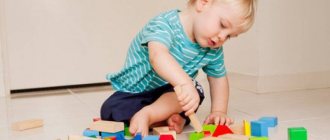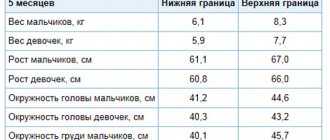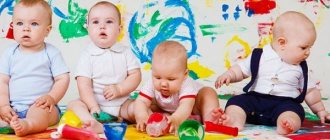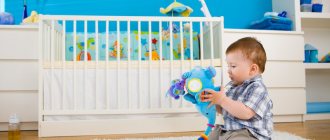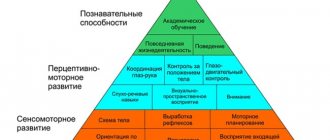The development of a 9 month old baby is very rapid. His physical and emotional state and intellectual abilities are improved.
A baby at this age is very active, so a revision of his diet is required in order to fully provide the body with the substances necessary for normal life.
It is useful for parents to know the developmental features of nine-month-old babies, possible deviations and ways to develop new skills.
Height and weight standards for boys and girls
The rate of weight gain and height increase at this age decreases.
During the ninth month, the baby becomes 1-2 cm longer and 450-500 g heavier. The baby adds about 4-6 kg to its weight at birth. Pediatricians evaluate the physical development of children according to approved WHO standard indicators. Boys and girls have some differences in physical condition.
Height values for children of different genders are shown in the table below.
| Index | Height in centimeters | |
| girls | boys | |
| Short | 65,3 | 67,7 |
| Below the average | 67,7 | 69,7 |
| Average | 70,1 | 72,0 |
| Above average | 72,6 | 74,2 |
| High | 75,0 | 76,5 |
| Very tall | 77,4 | 78,7 |
The standards for weight, head and chest circumferences approved by WHO are shown in the table below.
| Body Parameter | Girls | Boys | ||
| bottom line | upper limit | bottom line | upper limit | |
| Weight in kilograms | 6,5 | 10,5 | 7,1 | 11,0 |
| Chest circumference in centimeters | 41,0 | 46,0 | 43,0 | 47,0 |
| Head circumference in cm | 41,2 | 46,5 | 42,5 | 47,5 |
If the baby is under 1 kg or has a large body weight, this does not mean that he is developing incorrectly. If the baby is active, cheerful, and has a normal appetite, then this indicates his good health.
Each child develops individually.
The following factors influence the development of the baby:
- type of feeding;
- menu, power mode;
- degree of activity;
- number and duration of walks;
- activities with parents (physical exercises, massage).
It is recommended to show the child to the pediatrician periodically. After the examination, the doctor will tell you whether the baby is growing and developing normally, and whether any adjustments need to be made to his diet, rest and wakefulness.
Baby at 9 months
In the ninth month, the child’s body prepares for the first steps, the skeleton, muscles of the shoulders and hips are strengthened, and coordination of movements improves. At this age, children begin to actively move, crawl, and make more movements. Mom’s hands are becoming less and less interesting, and it’s getting harder and harder to sit in one place.
In the first months of life, children gain up to 900 g per month, at 4-6 months the weight increases by 600-750 g. By 9 months, physical activity increases, the child’s body spends more energy, so weight gain slows down. During the 9th month of life, body weight increases by 300-600 grams, height increases to 2 cm. The head and chest become larger in girth up to 1 cm.
You can measure your exact weight at home using an electronic scale. At 9 months, the baby is weighed while sitting, without clothes; he should sit in the center on the scales. To determine height, you will need a measuring tape, which is placed vertically along the wall. The child stands near the wall on the floor barefoot, one of the parents holds his hands.
Weighing on scales
Baby's skills and abilities
By the age of nine months, children already know a lot and continue to improve their skills. The musculoskeletal system is strengthened, so the baby becomes physically stronger. Vision, hearing, and motor skills improve. Parents need to know what a child should be able to do at 9 months.
Infants at this age are able to perform the following actions:
- respond to prohibitions;
- hold the head confidently and turn it in different directions;
- stand up leaning on a chair or sofa;
- actively crawl around the apartment. It is not necessary for the baby to move on his knees. Some children crawl using only their hands, without lifting their body off the floor;
- sit confidently without support;
- respond to an appeal to him;
- understand the meaning of sentences and phrases;
- hold toys in two hands, knock them against each other;
- clap;
- collect a pyramid. Children at this age still place rings in the wrong order;
- throwing things on the floor;
- tear and wrinkle napkins;
- look at small objects;
- pick up small things with your thumb and index finger;
- turning the pages of a cardboard book.
Some babies at 9 months already begin to walk with the support of their parents or leaning on a sofa or chair. At this age, intellectual abilities develop. According to research, a child's brain more than doubles in size. The sensitivity of the epidermal integument increases.
Memory improves. The child's movements become more meaningful. Kids love to play “Goat-dereza”, “Ladushki”, “Peek-a-boo”, and break towers built from cubes. Children like to look for toys hidden behind their backs or under the blanket.
Data from domestic pediatricians
How to develop a baby at 6 months
Standard indicators may vary depending on genetics, region, climate and other factors. The table shows how much a healthy child should weigh at 9 months according to domestic pediatricians. Unlike WHO data, the table of domestic doctors indicates the upper and lower limits of height and weight. The standard value is within the specified limits. Height is presented in cm, weight in kg.
Height and weight of babies at 9 months. according to domestic standards
| 9 months | Minimum indicator | Maximum indicator |
| Girl, weight | 7,5 | 9,7 |
| Boy, weight | 7,9 | 10,5 |
| Girl, height | 67,5 | 74,1 |
| Boy, height | 68,2 | 75,1 |
Neuropsychic development
Nine-month-old infants undergo intensive neuropsychic development.
Almost every day, parents notice certain successes and achievements in their child. The baby becomes more interesting in communication and emotional. At this age, children begin to pronounce syllables meaningfully. By the tenth month of life, infants not only pronounce certain sounds, but also begin to use them to designate specific people, objects, and actions.
Kids pronounce the syllables “ma-ma”, “ba-ba”, “pa-pa”, “dai”, “da-da”. At this time, it is important to stimulate the development of speech. Children at 9 months are able to perform simple actions at the request of their parents: for example, “give me a toy,” “take it in your hand,” “open your mouth.” Toddlers can point with their fingers at an object named by an adult.
Nine-month-old babies strongly feel and adopt the mood of those around them. At this age, a favorite toy usually appears. With her, the baby falls asleep and calms down. Despite the presence of a large number of toys, children prefer to play with household items: paper, plastic cups, spoons. This promotes the development of cognitive abilities.
You should not prohibit your child from playing with household things. It is important to ensure a high level of safety: do not give objects that could injure the baby; all things must be clean.
The following factors influence neuropsychic development:
- family atmosphere;
- time and mode of sleep and rest;
- sufficiency of parental attention.
Girls develop emotionally faster than boys. They are more attached to their parents and affectionate. Boys are more independent and inquisitive.
Child development
Rating 10List of indicators of emotional, physical and cognitive development of a child at 9 months |
- Type
- Ask
- Send to a friend
- Share
- subscribe to news
Nine months is the age when a child can not only crawl, but also stand with the support or support of his parents. At this age, the child develops new abilities. He may call you “mom” or “dad” for the first time - and it’s adorable!
By the age of nine months, a baby has developed a number of new skills that indicate healthy development. In this article, we will look at the key physical, cognitive, social and emotional development indicators of a nine-month-old baby.
List of developmental indicators for a nine-month-old baby
| Existing development indicators | Emerging development indicators |
| The baby crawls for short distances and then sits down | Baby crawls faster and over longer distances |
| Child stands with support | The child can take 1-2 steps with support or support |
| The child can say "mom" and "dad" | The child can speak more one-syllable words |
| The child understands the word “no” | The child can understand simple words such as “yes”, “come”, “go away”, etc. |
| The child repeats simple gestures | The child repeats a wider range of gestures and actions |
| Baby's eyes have depth perception | The child's depth perception improves, he can see objects at a greater distance |
| The child holds and drops objects at will | The child gives away objects when asked |
| The child gets his favorite toys | The child shows sympathy for certain people |
| A child transfers objects from one hand to another | A child can put an object in a box |
| The child is nervous in the presence of strangers | The child is nervous or shy in the presence of strangers |
Developmental indicators of a nine-month-old baby
All development indicators can be divided into the following categories: cognitive, physical, social and emotional. In each of these areas, the child develops certain skills.
Development of the cognitive (cognitive) sphere
These indicators relate to analytical thinking, judgment and general mental abilities of the child.
1. The child copies gestures and sounds. Copying a gesture or repeating a sound requires certain cognitive abilities. At nine months the child can already do this. When mom or dad looks at the child and shows a certain gesture or makes a sound, the child understands that he needs to repeat it.
2. The child can pronounce not only individual sounds, but also syllables. He can not only repeat sounds and syllables after his parents, but also pronounce them independently.
3. The child understands the word “no.” He understands that “no” means a prohibition to do something, and he obeys. The child understands the meaning of this word and over time tries not to do what his parents forbade him to do.
4. The child points to objects or people that interest him. A nine-month-old child knows that such a gesture means that an object or person is interesting to him. For example, a child may point to a toy in a store. This means that the child wants to receive it. The child may also wave his hand when he is told, “Bye.”
5. The child loves games like “peek-a-boo” or when parents hide objects. At this age, children have a sharper memory, so they love games with searching for objects. As a rule, the child knows the exact place where the parents hide the object. At nine months, the child is already developed enough to understand that hidden objects do not disappear, but lie in the place where they were placed. This understanding in psychology is called object permanence.
Physical development
This includes developmental indicators related to growth and development of gross and fine motor skills.
6. The baby is crawling. This is an important stage in the physical development of a child. By the ninth month, the baby easily gets on all fours and crawls. It's time to secure the apartment for the child.
7. The child can sit without support. At nine months, he not only crawls, but can also take a sitting position. Over time, as your child's lower back muscles become stronger, he or she can sit longer and enjoys playing while seated.
8. The child can stand with support. At this age, the child's leg muscles become stronger and can support body weight. The child can stand on his feet, leaning on something, and continue to stand for some time.
9. The child can grasp objects with the index finger and thumb. The baby's fingers are already developed enough to grasp small objects with two fingers. For example, this is how a child takes pieces of food and puts them in his mouth. You should remove small objects away from the child so that they do not get into his respiratory tract.
10. The child develops a parachute reflex. The child puts his hands in front of him when he is in an upright position and makes a sharp movement forward. This is how the child tries to prevent himself from falling.
11. The child develops hand movements. He learns to hit objects in his hands against each other and clap his hands. At nine months, children can not only transfer objects from hand to hand, but also throw them a short distance.
12. The child's eyes follow moving objects. The baby's eye muscles become stronger, allowing him to track moving objects. The child watches the toy car that you roll across the floor, or the handkerchief that you drop. He may also point his finger at an object that has fallen on the floor. Because the child has better developed depth perception, he can better judge the distance between objects.
13. The child sleeps an hour more at night than before. On average, a nine-month-old baby sleeps 14 hours a day. Now he sleeps less during the day, but compensates for this time with longer sleep at night.
Social and emotional development
In addition to physical and cognitive development, the child must develop social, emotional skills and behavior patterns.
14. The child demonstrates affection for his parents. He enjoys having his parents around and cries when his parents leave. The child likes to be hugged by his parents, he smiles and shows signs of joy.
15. The child gets nervous when strangers are near him. Around strangers, he panics and starts crying. This reaction is called separation anxiety. Even if the stranger is friendly and tries to play with the baby, the baby will crawl towards the parents.
16. The child gets his favorite toys. You may notice how your child constantly plays with the same toy, despite the fact that there are others nearby. At the age of nine months, the child's preferences for certain objects peak.
17. The child loves when familiar faces are nearby. He feels best when he is surrounded by his parents, grandparents and other close relatives. He understands that his parents are leaving one unit - a family. The child will always be safe with them. The child rejoices at his parents and loved ones and is always ready to play with them.
Most children reach these developmental milestones by nine months of age. However, remember that each child develops at his own pace, and therefore some indicator may develop later. However, there are signs that may indicate developmental delay.
What might be a cause for concern?
If a child has delays in any areas of development, this will interfere with his further development.
1. The child does not sit down or crawl. The ability to sit and crawl are key development indicators for a nine-month-old baby. If these skills are not developed, this indicates problems in physical development. You should immediately contact your pediatrician.
2. The child cannot stand with support. At nine months, the child partially supports his body weight on his legs, and partially transfers it to a support. If he cannot stand on his feet with support, this may indicate a developmental delay.
3. The child does not make any sounds. If the baby is suspiciously quiet and does not make any sounds, this may also indicate a developmental delay.
4. The child does not recognize the faces of parents and loved ones. At nine months, the child recognizes familiar faces and greets them with a smile. For example, when one of the parents returns from work, the child perks up joyfully. The same thing happens when grandparents come to visit - the child can remember them and enjoys them. If a child does not react in any way to familiar faces, this means that he cannot remember them. This indicates a developmental delay.
5. The child cannot hold objects in his hands. If a child is unable to independently grasp objects or pieces of food with two fingers, or his hands are so weak that he cannot hold objects, this may also indicate developmental problems.
Other signs of developmental delay may include tight or overly relaxed arm and leg muscles, limited muscle movement, or lack of coordination between the neck and head when picked up. In order to promptly identify and eliminate all possible developmental deviations, it is recommended to regularly check the child with a pediatrician.
5 Tips to Support Healthy Child Development
Let's look at some simple tips that parents can use to promote healthy child development.
1. Let your child play. Playing is the best way for a child to strengthen muscles and develop motor skills. Make sure your child spends enough time playing. During the game, give your child simple instructions, for example: “give mommy the ball” or “throw it there” and show the place. Such cooperative games develop a child's physical and cognitive skills and promote his growth.
2. Read books with your child and explore the world around you. Nine-month-old babies love brightly colored picture books. Sit your child on your lap, read a book to him and let him look at the illustrations. This activity develops the child's vision.
Walk with your child in the park. The baby will see different shades of colors and this will also stimulate his vision.
3. Teach your child the names of objects. Point your child to an object and name it (for example: “This is a sofa”). Show your child various gestures and explain what they mean (“Say “bye”). A nine-month-old baby may not yet repeat the word or phrase after you, but he will remember it and try to pronounce it.
4. Teach your child to eat on his own. Place a plate of food in front of your child, cut into pieces. Let your child take food from the plate himself. This activity develops fine motor skills. When a child learns to grasp objects with two fingers, he will master more complex movements. However, make sure that the child does not swallow small objects - they can get into the respiratory tract.
5. Spend time with your family. Take the child in your arms and approach each family member, calling him (for example: “This is auntie”). The child will remember all the relatives by sight and remember what they should be called.
If a child is healthy, he easily achieves the required development indicators. But if you suspect the slightest deviation, take your child to the doctor. The earlier you detect a developmental delay, the easier it can be corrected.
Rate this publication
Article rating: 5.00
out of 5 based on
2
ratings.
Related links:
- ▶ Child at 7 months: main indicators
- ▶ Developmental indicators of a 5-month-old baby
- ▶ Developmental indicators of a 4-month-old baby
- ▶ Developmental indicators of a 3-month-old baby
- ▶ Developmental indicators of a 2-month-old baby
- ▶ Developmental indicators of a 1-month-old baby
- ▶ More articles on child development
Child development 01.10.2020
What signs indicate developmental delay?
It is important for parents to ensure that their child’s development proceeds correctly. To do this, it is recommended to compare the indicators of the National Development Calendar with actual data.
Developmental delays can result from:
- lack of attention and care of parents;
- lack of developmental activities;
- stressful situations;
- lack or excess of nutrition;
- incorrect daily routine;
- congenital or acquired severe diseases.
Parents should be alert if their child:
- does not make sounds;
- does not respond to his name;
- does not respond to requests from adults;
- cannot sit;
- sleeps a lot, is apathetic or too excited;
- moves reluctantly;
- not interested in toys or household items.
If there are signs of developmental delay, you should immediately contact a pediatrician or pediatric neurologist.
At the age of nine months, violations are usually easily corrected by parents with the participation of specialists. Therefore, you should not neglect the baby’s condition or delay treatment.
How to develop a child in the ninth month of life?
In order for the baby to continue to develop at 9 months, it is necessary to conduct training sessions. The emphasis should be on improving motor skills and manual dexterity, speech, logical thinking, imagination, and strengthening muscles.
A child should have the following toys:
- soft cubes;
- cars;
- children's musical instruments (drum, piano);
- dolls;
- colorful books;
- constructor with massive elements;
- tumbler;
- sorters;
- pyramid.
It is important to pay attention to the properties of game items: they should be easy to use and care for.
Fine motor skills
It is important to train the fine motor skills of a nine-month-old baby. Scientists have proven the connection between the development of manual dexterity and the development of speech. It is recommended to introduce the baby to toilet paper: show how it unwinds.
The baby will be happy to tear and scatter parts of the roll. You can also stick a piece of tape to your palm. The child will begin to study the shred and try to tear it off.
Another option for developing fine motor skills is to look for toys in a bowl of cereal. To improve tactile perception, it is worth letting your baby touch objects of different textures: rough, smooth, hard, soft.
Useful for fine motor skills and drawing. Babies at 9 months do not yet know how to hold pencils and brushes in their hands or use watercolors. You can introduce your child to finger paints. Drawing promotes the development of imagination and creative skills.
Physical activity
If a child at 9 months cannot crawl, then every effort must be made to develop such an ability. To do this, you should create support for two legs alternately.
Children's house with a tunnel
If your baby crawls well, then you should buy him a house with a tunnel. The baby will actively move around in it, reinforcing the learned skill. Often the reason that a child does not begin to walk or crawl is muscle weakness.
To strengthen muscles, it is recommended to perform massage and various physical exercises (especially on a fitball). It is advisable that the manual treatment be carried out by a massage therapist. You can use simple massage techniques at home. A set of physical exercises can be easily found on the Internet or developed with a specialist.
An example of gymnastics for infants:
- place the child in front of the stroller in such a way that it is comfortable for him to hold onto it with his hands;
- Begin to carefully and slowly move the child's vehicle forward. The baby will reach for the stroller and take his first steps;
- Place the child on the gymnastic ball with his back to you. Holding it by the hips, begin to tilt the fitball in different directions. This exercise develops coordination well;
- Pull a long string between the furniture at the level of the baby’s knees. Holding the baby by the hands, force him to step over the barrier.
Nine-month-old babies love to help mom or dad around the house. This desire cannot be ignored. Boys can be given construction-themed toys, and girls can be given plastic dishes, involving them in the process of using such items. Swimming has a beneficial effect on physical development.
It helps not only strengthen muscles, but also improve mental abilities. If parents practiced the method of early learning to swim, then the baby should already be able to float well on the water by 9 months. It is important that classes are well organized and regular.
Speech skills
For proper speech development, you need to communicate a lot with your baby. The child is still pronouncing syllables, but his passive vocabulary is actively being formed. Adults are encouraged to use simple words when speaking.
It is important that all family members communicate in the same language. Bilingualism often causes delays in the development of a child’s speech. It is worth engaging the child in conversation and asking him simple questions.
The baby cannot respond yet, but he will try to make different sounds. Parents are advised to repeat the spoken syllables after the child. Reading aloud children's books, poems, and singing also stimulates speech development. Some parents practice showing their children cartoons on the computer or TV.
But this is a flawed approach to learning. Live communication is important for a child. It is useful to conduct classes with Doman cards. They depict various objects, and their names are indicated below. It is recommended to use cards of different subjects.
The child's education should take place in a playful way. It is not recommended to work with a child if he is sick or in a bad mood. The baby needs to be developed comprehensively and step by step.
Educational activities and games
It is important to conduct educational games with children. It's useful and interesting.
- Put in the box fabric of different textures, soft and hard, wool, you can also put corks, a playing card. The child selects the material by touch, thereby improving tactile perception.
- Turn the toys upside down, the baby must correct the situation.
- Take a tour outdoors or in nature. Point to objects, animals, talk about them.
- Hide the toy so that only part of it is visible. The child must find her.
- Place construction sets with large parts and pyramids.
- Hide the items in a transparent box. To get them, the child needs to open them. See if he can do it. Help him if it is difficult to do this right away.
- Give me the toy. Put three different toys, ask for one and name it. If the baby did everything correctly, feign delight.
- Arrange everything so that the child has his own play area in every corner of the house. In the kitchen there are pots and plates, in the bathroom there are toys that float. Dressing can also be made into a fun game by doing things like playing with a hat in front of a mirror. It will be interesting for the baby to see the reflection, which together with him takes her off her head.
- Roll the ball to each other on the floor.
At 9 months, a baby already becomes independent, shows joy and dissatisfaction, and shows character. A little more, and the baby will walk and talk, and parents need to stock up on even more patience and love. After all, raising a child is the most important thing in our life.
Diet for a 9 month old baby
In the first year of life, children actively develop and spend a large amount of energy. To replenish their strength, they need proper nutrition. Babies who are nine months old are still breastfed. Breast milk contains beneficial vitamins and minerals.
But these substances are not enough for a child of this age. The main source of energy and necessary elements are products of general consumption. It is important for parents to understand that the baby's digestive system is not yet functioning properly.
Therefore, the body is not able to absorb rough food. It is important to take a competent approach to developing menus and preparing dishes.
The diet of 9-month-old children usually includes the following foods:
- fruit and vegetable purees (from beets, apples, green peas, cabbage, carrots, rutabaga, pumpkin, plums);
- natural juices;
- lettuce, green onions, dill, parsley;
- porridge (buckwheat, rice, oatmeal, pearl barley, barley);
- butter and vegetable oil (in small quantities improve digestion and strengthen the immune system);
- fermented milk products (kefir, cottage cheese);
- meat dishes from chicken, turkey, veal;
- fish (sea varieties are good for mental development due to their iodine content);
- eggs.
Fruit puree
Cooking food for a 9-month-old child should be done by steaming, stewing, or boiling. It is strictly prohibited to give store-bought processed foods and sweet drinks to your baby. Infants at this age eat five times a day. The interval between meals is 4 hours.
Feeding on a schedule ensures maximum absorption of nutrients, eliminates overeating or undereating, and prevents problems with the digestive system. An approximate diet for children 9 months old is shown in the table below.
| Time | Features of eating |
| 6:00 | Drinking breast milk or an adapted formula after waking up |
| 10:00 | Full breakfast. Includes hearty and satisfying dishes in the form of porridges. Breakfast made from buckwheat is especially healthy |
| 14:00 | Dinner. Differs in variety. At this time, it is recommended to serve vegetable and meat dishes (stews, meatballs) |
| 18:00 | Light dinner. Heavy food can cause abdominal pain and sleep disturbances. It is allowed to give the baby a small amount of cottage cheese, kefir, fruit puree |
| 22:00 | Late dinner. Presented with breast milk or an adapted formula |
Experts also give the following recommendations:
- To develop chewing reflexes, it is worth giving less pureed foods. It is better to boil the products and then mash them with a fork;
- it is important to give your child only fresh food;
- When introducing a new product into the diet, an allergy test must be performed;
- If your baby refuses to eat a certain dish, then you shouldn’t force him. You can offer this product after 1-2 weeks;
- do not abuse sugar;
- It is useful to include the child in the family meal. This will promote a good appetite.
Child care rules
To ensure that your baby does not get sick, feels good and develops normally, you need to take proper care of him. After waking up, you should wash your face. Parents should clean their child's ears and nose as needed. After each bowel movement, you should use wet wipes or wash the baby.
You need to bathe your baby regularly.
It is better to do this in the evening. Water procedures relieve nervous tension, relax muscles and improve sleep. Soap is allowed to be used no more than once a week.
After each bath, the child's skin must be treated with moisturizer. If your baby is wearing diapers, you should make sure that diaper rash does not appear. Air baths, during which the child is left completely naked, are useful. This procedure can only be carried out if the indoor microclimate is optimal.
At nine months, children already have teeth. It is important to regularly perform oral hygiene.
